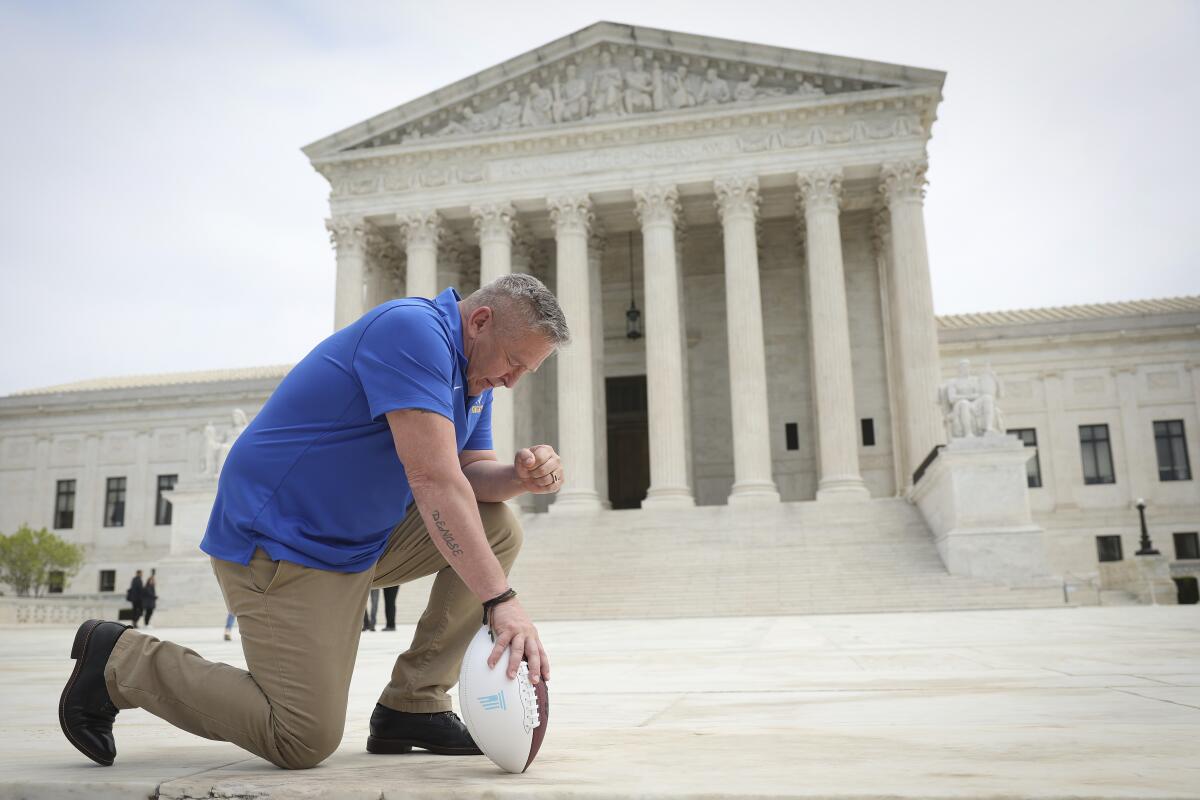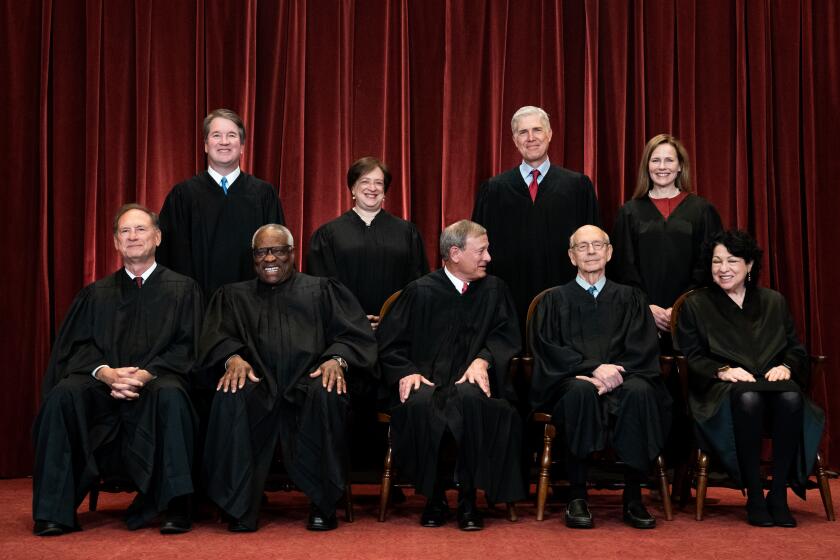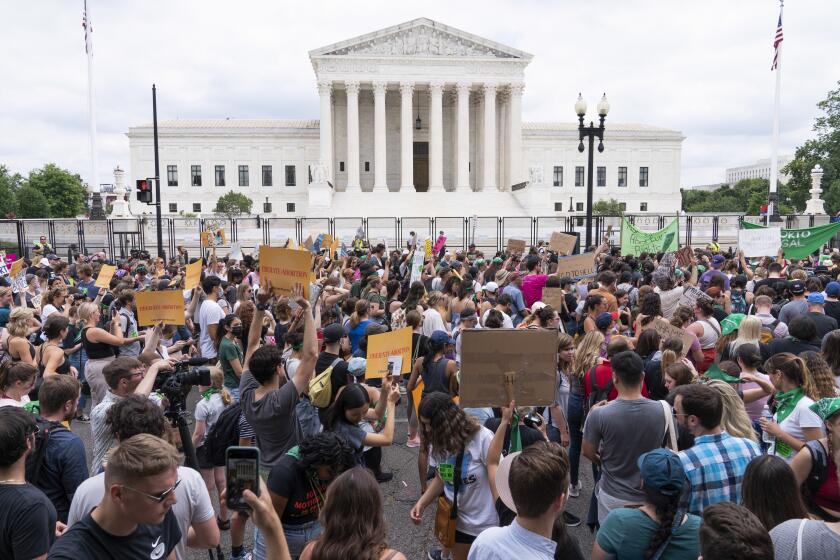Editorial: The Supreme Court ruling on school prayer deserves a big fat F

- Share via
Ruling last week in favor of a football coach who insisted on praying on the field, the U.S. Supreme Court threw out 60 years of legal precedent, leaving the nation’s schools in the untenable position of having little recourse to protect students from religious coercion on campus.
The court has ruled repeatedly since 1962 that the Constitution’s wording against governmental establishment of religion prohibits prayer in the class and at other school functions such as graduation ceremonies. Students are captive and impressionable audiences; proselytizing on behalf of any religion devalues other religious beliefs. Their teachers and administrators hold sway over many aspects of their lives. Will they get a good grade? Make it on the team?
It’s not enough for school staff not to impose obvious consequences on students who don’t join their prayers. Students and their parents should never be made to feel as though this is a possibility, nor should they be encouraged to join a teacher’s prayers.
The actions of former coach Joseph Kennedy in Bremerton, Wash., wasn’t as clear a violation of the separation of church and state as when prayers were blasted through schools’ sound systems. But it clearly flunked the test of making all students’ beliefs seem equally valid. The prayers occurred just after school games, on school property, while Kennedy was on the job. Kennedy invited students and others to join him.
For more than 50 years, the court has ruled that prayer in public schools violates the 1st Amendment’s prohibition against the establishment of religion.
Writing for the court majority, Justice Neil M. Gorsuch so badly twisted the reality of the case, he could join Cirque du Soleil as a contortionist. He described Kennedy’s prayer as short, private and personal, and the students as “otherwise occupied” during the prayer. Hardly.
This wasn’t a private expression of religion. It was a display meant for others to see. Kennedy may have not forced anyone to join, but he created a religious in-group. At least one parent of a player on the team complained that their son felt compelled to join in even though his beliefs differed.
The school offered Kennedy a more private place where he could pray after games, but he insisted that his religious beliefs required him to do this on the football field. The district also said it was fine for him to use the field if he waited until the students were gone. He refused that too; it’s hard to believe that his intention wasn’t to make this a public spectacle. In fact, at one point he said that his purpose was to make the students “better people.” That isn’t private or personal. It’s proselytizing.
Writing the dissenting opinion, Justice Sonia Sotomayor noted that once Kennedy was no longer at the Bremerton High football games, there were no more displays of after-game prayers. In other words, the students were being influenced by Kennedy’s actions.
Sotomayor summed it up correctly by writing: “This case is about whether a school district is required to allow one of its employees to incorporate a public, communicative display of the employee’s personal religious beliefs into a school event, where that display is recognizable as part of a longstanding practice of the employee ministering religion to students as the public watched.”
It’s not hard to imagine how far the court might let this kind of behavior go. The old loudspeaker prayers aren’t coming back under this newest ruling, but it’s unclear how far school employees’ right to “personal private prayer” might go. Can a kindergarten teacher begin audibly praying in the classroom and invite the children to join? Can a principal lead a prayer in the auditorium during the intermission of the high school play?
When the court departs from where the people stand, a popular reaction generally leads to a correction. But this takes activism and time.
There’s also reason to wonder whether the court majority would have reached the same conclusion if the football coach had invited students to join him in Muslim prayers.
Since 1973, conflicts over religious displays have relied on the “endorsement test,” which looks at whether a governmental action communicates endorsement of religion. The new decision specifically throws out the precedent that has guided public agencies for nearly half a century. Instead, Gorsuch wrote, schools and other government agencies should consider “historical practices and understandings” in determining whether the government is endorsing one religion over another.
It’s unclear precisely what he means by that, but historical practice in this country has been overwhelmingly Christian as the dominant religion; relying solely on what happened historically could result in giving too little respect to the rights of religious minorities, as well as shifts in religious belief. Nearly 30% of American adults don’t identify with any religion at all, up by more than 10 percentage points over a decade ago. The percentage of those identifying as Christian fell accordingly.
If the nation’s highest court insists on eroding the rights of more than a third of Americans — the nonbelievers and members of religious minorities — there is little that individual schools or states can do. But that doesn’t mean they should throw in the towel. Gorsuch’s wording can still be a matter of interpretation, and public schools should go to the mat on avoiding religious displays by staff on impressionable youths.
Good for Los Angeles Unified School District Supt. Alberto Carvalho for sticking with a policy that says staff can pray only on their own time and away from a school event — though a football coach at Dorsey High says that he leads prayers with his players before and after games.
California has no specific laws on school prayer, and even if it did, those could be thrown out by the high court. Nonetheless, state Supt. of Public Instruction Tony Thurmond should be drawing up clear guidance that spells out the many cases in which students could be felt coerced into joining a religious activity, and situations in which a school employee’s prayers should be accommodated.
And this should be its driving message: No student should be proselytized or encouraged to accept any religious belief. No classroom or student extracurricular time can be used for public prayer except for specifically religious clubs. Records must show that students who declined to join teachers in prayer didn’t suffer consequences such as lower grades, worse roles in the school play or being denied teacher recommendations. Schools must proactively drive home the message to its employees and students that all religious beliefs, or no belief, are equally welcome and equally protected.
More to Read
A cure for the common opinion
Get thought-provoking perspectives with our weekly newsletter.
You may occasionally receive promotional content from the Los Angeles Times.












